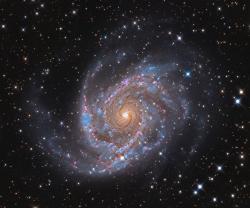
Howdy, Stranger!
It looks like you're new here. If you want to get involved, click one of these buttons!
BlockHead
About
- Username
- BlockHead
- Joined
- Visits
- 257
- Last Active
- Roles
- Member, Administrator
Comments
-
Hi Joe, Ok. So my reaction is... this isn't what or how I teach. In my videos I am striving to do something different for precisely the reason you feel overwhelmed. You will find out there many other content creators suggesting different "options" f…
-
Generally yeah, you limit to the session because comets are changing constantly. You literally have a different object each night. Consider this... one night the tail is BRIGHT...the next night it isn't... or the angle of the tail has shifted. Now w…
-
In general you should not have take any action at all. Registration (StarAlignment) will figure out how to align the files whether they are flipped or not. Typically you might have a difference in image quality (not flipped state) that is causing th…
-
Raymond, 1. The structures you point our are clipped in your data. They have a harsh discontinuity due to the processing choices you made. You might consider the 0.8 rule of thumb when processing images- I think you will find it helpful.2. It appear…
-
Hi Joe, Can you please expand on your question a bit. I will engage you in this discussion as I think it is important to understand the way that I think about these things as it does infuse the content I create. I am quite curious about what you mea…
-
Hi Raymond, Could you please show a screenshot of the features? -the Blockhead
-
Yeah... In FastTrack...I did suggest get the entire Universe (catalogs)... I know it seems like unnecessary... but...-the Blockhead
-
It solved just fine. see attached. -the Blockhead
-
There are two issues you are encountering. You need to understand the issues first- then the solutions will make more sense. In the case of the Jellyfish- you need to stretch the image more- but not make either the color or brightest parts become "s…
-
Hi Greg, Please begin by showing me a picture that shows your work..and another that shows what you are striving to achieve. If you want to brown-nose... choose one of my pictures that fits the bill. :) -the Blockhead
-
I just re-read my message.Let me state this a little more clearly.When I began astrophotography and generating images 25 years ago- there were no references.There was nothing to compare to in terms of other RGB images of many objects. I learned to l…
-
Tim, Even though you gave me low quality data since it is not the entire stacked image and only the LN images... I think you make my point. I just recently asked if I could announce my new course on Comet image processing on the FB group called "Co…
-
Sorry...I am a little confused. Why are you uploading the LN references and not the master lights? -the Blockhead
-
Hi James, I think I need a new rule on this forum.I think no questions can be asked without some screenshots! lol 1. Is the image stretched?2. Did you run BXT?3. Did the console indicate there were sources detected? How many? -the Blockhead
-
This is what I get when I apply my trick.The lighten trick did not work... so I just did the clonestamp on the rotated image. Do you think this would make a good video to demonstrate? -the Blockhead
-
You would make the master light frame available via a cloud server (Google Drive, OneDrive, DropBox...etc).Remember to set the permissions to *anyone that has the link* can get the file. -the Blockhead
-
My video may be dated... things evolve.I would need to dive back in..but I think this is because of the new measurement and weighting steps that happen in WBPP (this began a few years ago). -the Blockhead
-
I do not have a great suggestion.One thing you can take advantage of is that stars are round (reference quote needed).If the issue is on one or two stars... you can grab a preview around a star.Then you rotate the image. Then substitute this back in…
-
There is no upper limit... so ... 50?-the Blockhead
-
Yes. You might want to be more aggressive. It is easy to tell.. just look at the result. However, you really need to take SO MANY images...for this kind of flats to work...that with so many images- even the default rejection will likely work just fi…
